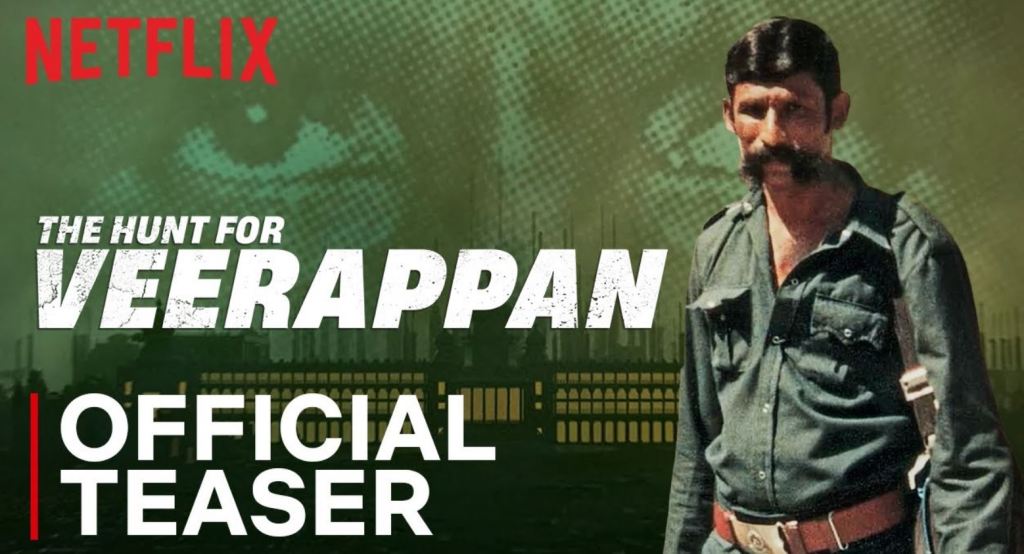
An Awedacious docuseries on the hunt for India’s most dangerous brigand – Beyond Bollywood
No hagiography as director Selvamani Selvaraj largely sticks to the ‘hunt’ narrative. The version of Veerappan’s widow and few surviving, reformed gang members all combine to give a balanced perspective.
Rating: ⭐️⭐️⭐️⭐️ ( 4 / 5)
By Mayur Lookhar
It came as a shock when dreaded brigand Veerappan [52] was gunned down on 18 October, 2004. A man who poached tuskers, plundered state wealth [sandalwood], killed scores of security men for over a decade, how could such a figure be gone overnight? Skepticism wasn’t rooted to two states [Karnataka, Tamil Nadu] alone. The rest of India long held a view that how could a bandit, terrorist hold two states to ransom for over a decade? Surely, he didn’t smuggle the loot directly to his clients! It would be unimaginable to think that he carried out the multi-million dollar smuggling without some patronage.
Near 19 years after his death, there still isn’t much clarity over the wider nexus. As even the new Netflix documentary reveals, Veerappan perhaps truly owned the jungle. According to his former accomplice Anburaj, Veerappan claimed to know every animal/bird their kins, every tree, plant, every corner of the jungle. The jungle was his home this despite the brigand looting it for years.
Every criminal adds stories to create a hype around him. Veerappan, too, was no different. However, director Selvaraj Selvamani’s docuseries The Hunt for Veerappan [2023] underlines the challenges that the police, forest officials later many Special Task Force teams faced in tackling this brigand.
The dense Male Mahadeshwara Hills, that border Karnataka, Tamil Nadu, required a tedious combing operation. With a gang of over 150 members, plus many spies in the local village, Veerappan was indeed a tough nut to crack.
After his death, the man bizarrely became a source of inspiration for voyeuristic filmmakers to create their jungle noir. Though an entirely fictional film, one can’t help but draw some parallels with Allu Arjun’s sandalwood smuggler in and as Pushpa [2021]. Ram Gopal Varma first made a fiction drama Jungle [2000]. Years later, he would make a biopic, titled Veerappan [2016]. We didn’t see that film but the trailer appeared to be glorifying the criminal.
This reviewer was a little skeptical about watching The Hunt for Veerappan fearing this would be another glorification. What drew us to this docuseries was the ‘hunt’ in its title. How the hunter became the hunted. Produced by Apoorva Bakshi’s Awedacious Orginals, this docuseries is no hagiography. Veerappan had gained notoriety from the time he poached tuskers. Some say he killed over 1000 tuskers. Once there were no tuskers left, he smelled money in sandalwood.
In his eyes, he was no different from the state who exploited the natural resources, while the local inhabitants remained poor. Ah, we’ve heard that story before. All criminals chide this to justify their actions. The 4-part series simply sticks to documenting the many attempts to kill the dreaded brigand.
This was a cat and mouse chase except that Veerappan was the clever cat, whilst the police, STFs needed to move around like mouse to get even remotely close to their target. Naturally, the chief commentators here are the key security personnel who were entrusted with the task of taking down Veerappan at some point of time to the men who eventually did the job – N.K Senthamaraj Kannan, K. Vijay Kumar. Other important commentators include B.K. Singh, former Forest Officer, Former Karnataka STF officer ‘Tiger’ Ashok Kumar, investigative journalist Sunaad, photojournalist Sivasubramanian, Nakeeran Editor Gopal. Then there are comments by Veerappan’s former gang members, but more importantly an extensive coverage to the late brigand’s wife Muthulakshmi. She chose to marry him all at 15. Veerappan was 39 then. Ashok Kumar didn’t hesitate to say that if not the bandit’s wife, Muthulakshmi could have been a Tamil cinema beauty. How does Muthulakshmi use this (documentary) platform?
All along she strives hard to prove that her husband was bad, but not quite the monster the world made him out to be. Veerappan is hailed as a doting husband. Keeping in with objectivity, it is fine to humanize a Veerappan but there are moments where you fear Muthulakshmi, Anburaj are trying to build a certain empathy around the bandit. You despise Muthulakshmi for justifying her husband’s brutal killing of the noble, saint-like forest officer Srinivasan, a man who had successfully reformed many of Veerappan’s men.
Veerappan’s gang is said to have members from different caste. This dreaded bunch toed the haves and the have-nots line to justify their illegal, criminal activities. Though she initially lived in the jungle, as Ashok Kumar claimed, Muthulakshmi had access to urban commodities too. Muthulakshmi is the consistent figure in this series. Any sane viewer will have little empathy for Veerappan or Muthulakshmi. One is conspicuous by the absence of their daughter Vidhya Rani, who had joined the Bharatiya Janata Party in 2020. All along, Rani has repeatedly requested to not associate her with the actions of her late father. There is nothing that we see hear from the other daughter Prabha either.
The Hunt for Veerappan is rightly more about the successive attempts to kill the most wanted criminal. While it does pay homage to the Srinivasans, Shakeel Ahmeds, Selvaraj doesn’t shy from also talking about alleged human rights violations under the garb of the brigand hunt. The role of couple of officers [Rambo Gopalkrishnan, Shankar Bidari] was seriously questioned. In one visual, Ashok Kumar is a hesitant to speak when the interviewer asks him about these allegations.
This balanced approach goes a long way in earning respect for Selvaraj and his team. The hard questions are posed to Muthulakshmi, too, who is speechless when the interviewer disagrees with the lady that killing people is no sign of bravery.
The first two episodes are largely about the man, the hunt that first began in 1989. Episode 3 covers the self-proclaimed revolutionary phase in Veerappan’s life as he justified his action as larger Tamil cause. The kidnapping of the late Karnataka matinee idol Dr. Rajkumar was the most audacious step that he took. 19 years later, Selvaraj succeeds in bringing out the tension of that period [2000]. He pays a fine tribute to Dr. Rajkumar, giving viewers a sense of his super stardom. How this kidnapping put extreme public pressure on the two state governments. The two states have always shared a frosty relationship. This kidnapping only aggravated the Kannada-Tamil divide.
The account by the survivors perhaps also presents a different, more humane side to Veerappan. The director though is mindful to not lull viewers into believing that the man was truly turning into a revolutionary. That Veerappan is rumored to have been given Rs10 crore as ransom is enough to dispel the revolutionary postering.
Like most dreaded criminals, they tend to have rather tame end. Episode 4 marvels at the intelligence, the drama that Kannan, Vijay Kumar created to get the snake out of his hole, and into their trap. For all the ferocious fighter hype, in the end there wasn’t one as Veerappan met his fate. The documentary also throws the different point of views in the aftermath of his death. For Kannan, Vijaykumar, though, this was a relief as the long terror reign had come to an end. It was a fitting tribute to the many martyrs, justice for the innocent civilians and even thousands of tuskers all who were killed by the monster.
The Hunt for Veerappan stands out for its gripping narrative, the quality of its commentators, tech brilliance. The theme song by Jhanu is eerie yet enticing. Overall, Selvaraj and his team are successful in giving you a semblance of all the pivotal events, conflicts, politics that came with this long hunt.
The documentary is currently streaming on Netflix.
Publisher: Source link


